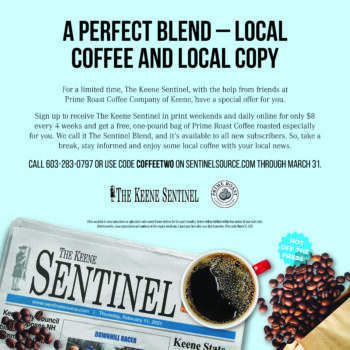How a 1-pound bag of coffee helped the Keene Sentinel reduce its digital subscriber churn
Terrence Williams, The Keene Sentinel,This is a series on Better News to a) showcase innovative/experimental ideas that emerge from the Knight-Lenfest Newsroom Initiative and b) share replicable tactics that benefit the news industry as a whole. This “win” comes from Terrence Williams, president and COO at The Keene Sentinel of New Hampshire. The Sentinel participated in the 2019-20 Table Stakes program held by the Poynter Institute.
Learn more about the Keene Sentinel’s partnerships and digital subscription efforts on the “It’s All Journalism” podcast.
Question: What communities do you serve and what can you tell us about the history of your organization?
Answer: The Keene Sentinel is located in the southwest corner of New Hampshire. It was founded in 1799 by John Prentiss, a book publisher, and first launched as the New Hampshire Sentinel. The paper has always been independently owned, mostly by two lineages, the Prentiss and Ewing families.
Today, it is owned by Thomas M. Ewing. The Sentinel serves the Monadnock Region, an area of about 30 towns and the small city of Keene. The region gets its name from Mt. Monadnock, one of the most-climbed mountains in the world.
Q: What problem were you trying to solve, and why was solving the problem strategically important for your organization?
A: Subscriber churn. Through Table Stakes work aimed at growing reader revenue, we recognized the importance of finding new customers and holding onto them.
Strategically, The Sentinel has pivoted to subscriber revenue as our principal revenue stream. For us, pressure sales or deeply discounted subscription starts have led to high churn rates and wasted money. We wanted a more reliable means of retaining new customers and therefore generating more income. Toward that end, we launched our Business Buy-in Readership Program in March of 2021.
Q: How is this approach related to Table Stakes (e.g. one of the 7 Table Stakes and/or an outgrowth of the Knight-Lenfest initiative, etc.)?
A: This initiative is related to Table Stake No. 5 (“Diversify and grow the ways you earn revenue from the audiences you build”), Table Stake No. 6 (“Partner to expand your capacity and capabilities at lower and more flexible cost”) and Table Stake No. 7 (“Drive audience growth and profitability from a ‘mini-publisher’ perspective”).
In particular, we targeted new readers, including those who prefer a digital subscription only or digital plus one day of print. We partnered with local businesses who were quick to sign up because of the marketing benefits of our program. Our retention team, which includes editorial, circulation, graphics, digital and administration staff, works in a mini-publisher manner with a focus on growing paid readership and profit.
Q: How did you go about solving the problem?

This is an example of a promotion from the Keene Sentinel to market their collaboration with Prime Roast Coffee.
A: Most of our subscription starts have been generated via offers delivered through our email database, which we scrub for current subscribers.Our permission database comes from a variety of sources – contests, subscribers, former subscribers and newsletter subscribers. These have had moderate success, but offers based on low pricing alone have seen churn rates in excess of 50% when full pricing approaches or is reached.
We have as an objective charging more with our initial offers, but recognize that higher pricing lowers volume. What if we offered a reasonable discount — 35% or so with a gift?
We developed a program that bundled locally produced goods from local businesses with subscription offers.
Our first was with a coffee roaster through which, at half-price, we purchased 1-pound bags of coffee to combine with an online-only subscription or weekend print delivery and full online access.
We set the price at $8 every four weeks, which is 35% off our full-price offer of $12.40. All subscriptions had to be on recurring credit card payments and would go to full price after 24 weeks. We thought the gift and the EZ Pay program might result in lower churn.
We publicized these offers in print and online, but our best method for acquiring paid readership has been through our email database, which we use frequently. In this case, since we were looking for new subscribers, we scrubbed the database of current paying customers and sent the remainder regular, weekly emails with this offer.
Our Retention Team, which developed this idea, operates as a mini-publisher, coming up with subscription and retention ideas, testing them, changing them, discarding those ineffective and with full authority to launch new initiatives. In this case, we also received help from members of our Customer Service team, which helped with order fulfillment, and members of our Revenue Team, which connected with local businesses for products to bundle with our offers.
Q: What worked?
A: The initial offer did well, by our standards and our operation size. We purchased 20 bags of coffee at 50% retail ($8) and quickly sold out, forcing us to order twice more.
The promotion ran for four weeks and generated 55 starts. Today, 10 months later and several weeks into full pricing, we have retained 44.
Revenue just on the retained subscribers is $3,634 and profit, after the cost of the coffee and delivery but exclusive of the discount, is $2,933.
We went on to partner with a candy company, a baker, a soap manufacturer, an oil and vinegar producer, a maker of rum and a chocolatier.
Total sales from the program to date are 341 and retained sales are 300, a retention rate of 88%. It should be noted, of course, that retention of recent subscribers is high, but on the offers sold through May, most of which have since gone to full price, the retention is 80%.
Total revenue on the retained sales only is $15,282 through October. The cost of the program, not inclusive of the discount, is $4,934, producing a profit of $10,348. For all products, with the exception of the rum tasting, we paid $8 each. The rum tasting was $20 per order.
Delivery is performed by a local company, which provides “white glove,” door-to-door delivery of the gifts. We pay them roughly $5 per delivery but also provide trade advertising for their business. For the few digital orders out of the market, we mail the products.
The retail partners like the program. Several have told us they would like to participate again.
Finally, churn rates did get better overall for our operation, particularly for online. In January, our churn rate was 4.36% for digital and 2.82% for print. In November, digital churn fell to 3.34% with the lowest level of 2.12% reached in June. Print is now 3.54% with its low watermark of 1.5% attained in May.
We paused the program in December 2021, as it’s typically a slow month for circulation starts, but we’ll be reinitiating the program in January 2022, hopefully with a wine tasting offer.
Q: What didn’t work?
A: Soap. This was not an attractive gift. We generated only 23 orders, though 19 subscribers are still with us.
Q: What happened that you didn’t expect?
A: Quite frankly, we didn’t expect the volume of orders we received. Again, we are a small news organization, so high start volumes are not the norm. Getting an average of nearly 50 new orders a month through this program had a meaningful impact on circulation.
Another surprise was the attractiveness of candy offers. Our April offer of one pound of candy generated 62 sales; our current offer of one pound of chocolates capped off at 70.
Finally, we had more online-only orders (175) compared to digital plus the weekend print paper (164). We thought, given both offers were the same initial price of $8, most orders would have included print. This was not the case, which suggests the digital component was seen as more valuable.
When we began the program, in March, weekend print subscriptions were 4,147; in November, we were at 4,031. Digital subscriptions, meanwhile, grew from 1,340 to 1,444 over the same period.
Q: What would you do differently now? What did you learn?
A: We may not have to pay for the retailers’ products going forward — or not as much. They received significant promotion through print and online marketing of the program — plus cash from us for their products. We can either ask for a deeper discount on their products or at no cost to us. That said, promoting these small businesses, which are still dealing with a pandemic, is viewed favorably by our readers.
Q: What advice would you give to others who try to do this?
A: A key for us was the delivery component and our quick fulfillment.
Consider asking a motor route driver to do this work and make the delivery special with attractive packaging. We received lots of favorable feedback from our new subscribers from this aspect of the program. The advertising staff was critical to finding business partners. We did not pay commission but we are considering some incentive going forward.
Also, a clean email database that does not include current subscribers is essential.
(Editor’s note: As described in a previous Better News piece, the Keene Sentinel successfully used its email database for a “grocery giveaway” sweepstakes, an online talent contest called Monadnock’s Got Talent and a pets photo contest. The Sentinel also used the database in a crowdfunding effort to support its COVID-19 coverage.)
Q: Is there anything else you’d like to add?
A: Below is an example of the promotion we used for an online plus weekend print offer.
